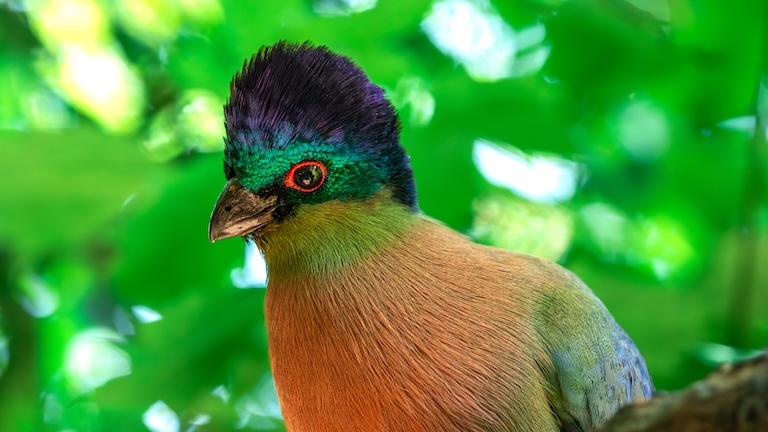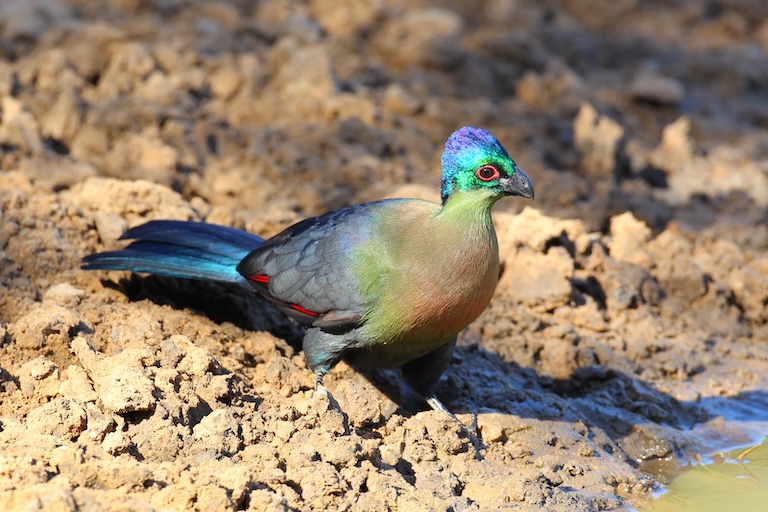Purple Crested Turaco Profile
Turacos are some of the lesser-known bird groups, mostly because they’re endemic to Africa, which to much of the world is thought to be a scary and inhospitable wasteland.
And that’s a pity in two ways: firstly, Africa is a brilliant and diverse continent larger than Europe, the US and China combined; and secondly, turacos are some of the most awesome birds in the world.
Hopping through tree branches like painted arboreal velociraptors, these highly colourful and intricately-sounding therapods are an incredible experience to bear witness to. And the purple crested turaco is a great entry-level turaco to get your teeth into.

Purple Crested Turaco Facts Overview
| Habitat: | Moist, wooded areas |
| Location: | Eastern Sub-Saharan Africa, from Southern Lake Victoria to Eastern South Africa, West |
| Lifespan: | Unknown |
| Size: | Around 40 cm long |
| Weight: | Around 300g |
| Colour: | Mostly purple with a green-brown neck and chest, red flight feathers, bright green face and orange eye ring. |
| Diet: | Fruit, berries, seeds, buds |
| Predators: | Raptors, |
| Top Speed: | Not known |
| No. of Species: | 1 |
| Conservation Status: | Least Concern (IUCN) |
These birds are medium-sized, medium-coloured and medium-sounding turacos, which says less about this species and more about just how dazzling they can get.
Even a mid-tier turaco is an outstanding animal, and these 300g purple berry feeders carry the flag well. They’re widespread across the eastern half of Sub-Saharan Africa, though deforestation has them in decline.
Interesting Purple Crested Turaco Facts
1. They’re banana eaters
Bananas come from a weird plant in the genus Musa, which is where this bird species gets its family name, Musophagidae, meaning “banana eaters”. Along with the adorable mousebirds, this family are loyal African bird species, endemic to the continent.
The Musophages include the go-away birds, whose call sometimes sounds like a judgement of banality: “Meh” or a Londoner trying to get your attention: “Oyy”; and the plantain eaters, who bubble with laughter as they come together on a branch.
Likewise, the turacos have unique and distinctive calls, often more complex than others in the family. The Purple Crested Turaco has a typically tropical jungle vibe, with an echoing croak or whoop that would sound fitting in Jurassic Park.
But outside of this groping of birds, nobody quite knows where the family sits. They were once thought to be related to cuckoos, but this has been debunked. As yet, their phylogeny remains unresolved.
While the name suggests they eat bananas, only a few species in the family do, and even the plantain eaters are fonder of other fruits. Purple crested turacos mostly eat seeded fruits, nuts, berries and buds.

2. They’re stunning
Like all turacos, this species has a range of vibrant colours in its plumage. When hopping about on a branch or sitting by a pond, it is already a very colourful animal, with a green-brown chest and neck and purple body and crest.
But in flight, there’s a surprise flash of red, exposed on the flight feathers of the wing, and then mostly obscured when it comes to light on a branch. And while up there in the canopy, their skills really shine. 1
3. They’re agile
These birds spend much of their time dancing through branches, looking for fruits.
Turacos prefer trees with plenty of mostly horizontal platforms, and many of their favourite feeding trees are happy to oblige. They are strong flyers, but when in the canopy, rarely need to use their wings at all, instead relying on their strong legs and agility to hop effortlessly between the branches.
This gives them a very dinosaur look, and coupled with the crest and the guttural call, they do conjure an image of what life in the trees might have been like before mammals took over.
As fruit eaters, they play an important role in supporting the plants they feed on, too.
4. They’re medium-sized seed dispersers
For reference, the largest (and therefore best) turaco is the great blue turaco: a beast with a crest that’s a quarter of the length of the purple crested turaco’s entire body and that grows to around 70 cm in length.
This puts our PC Turaco somewhere in the lower-middle of the size range, but it’s no less of an ecosystem servant.
The fruits and seeds this bird eats pass through it quickly, or are often regurgitated, which helps prevent breakdown of the genetic material of the host plant, and as the bird flaps about between trees, it shits viable reproductive material all over the forest floor and canopy.
5. But they’re indiscriminate
Ecology is an unpredictable and intricate machine, and this is exactly why conservationists need to be very careful about doing the right thing. Some tweaks can be helpful, others can be catastrophic, and it is almost impossible to know the true outcome in advance.
The purple crested turaco’s ability to disperse seeds is great for the native plants within its range, but for invasive plant species, it can be just as, if not better.
And this is giving invasive plant species an unhealthy grip on the ecosystem. Not only do these birds disperse seeds, but it appears that time spent inside the bird actually increases the chances of it germinating over simply throwing it into the soil. 2 3
6. Invasive Meltdown
Enter the invasive rose-ringed parakeets, where, in areas of South Africa where they have become invasive, they are filling a similar niche to the native turacos.
Only, these frugivores digest a lot slower, and this extended time in the gut reduces the viability of the seeds from invasive plant species.
Essentially, the seeds of the invasive plants are being damaged in the guts of the invasive parakeet, and not in the native turaco. This is a form of what’s called “invasive meltdown”, where one invader hinders another.
But this is still evidence of the overall negative effect of the rose-ringed parakeet, or as it’s also known, the ring-necked parakeet – an animal whose introduction to much of Europe is still being assessed for negative effects.
7. They’re doing ok
The species is listed as of Least Concern by the IUCN, but they’re not by any means immune to the pressures of deforestation occurring across their range.
Swathes of moist forest canopy is being replaced by invasive eucalyptus plantations with no fruit or horizontal branches for the turacos, and this is reducing the viable habitats for them.
Their numbers are dropping, but as of yet, they haven’t reached a concerning low. Conservation efforts need to be focused on protecting areas of woodland for these, and similar species. 4

Purple Crested Turaco Fact-File Summary
Scientific Classification
| Kingdom: | Animalia |
| Phylum: | Chordata |
| Class: | Aves |
| Order: | Musophagiformes |
| Family: | Musophagidae |
| Genus: | Gallirex |
| Species: | porphyreolophus |
Fact Sources & References
- “Purple-crested Turaco”, eBird.
- GÉRALDINE VERON (2008), “Phylogenetic relationships within the turacos (Musophagidae)”, Wiley Online Library.
- Vuyisile Thabethe (2015), “Ingestion by an invasive parakeet species reduces germination success of invasive alien plants relative to ingestion by indigenous turaco species in South Africa”, Springer Nature Link.
- “Purple-crested Turaco”, IUCN Red List.
